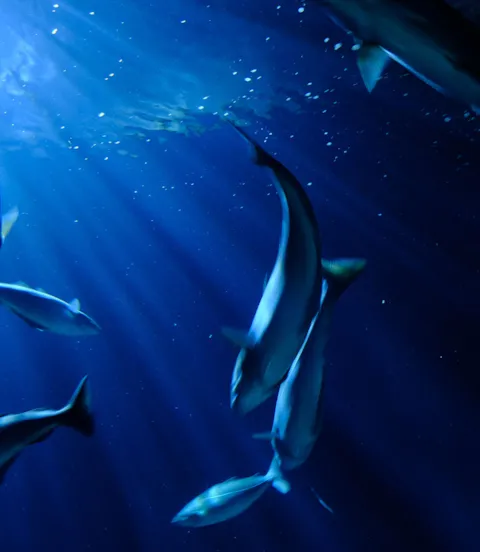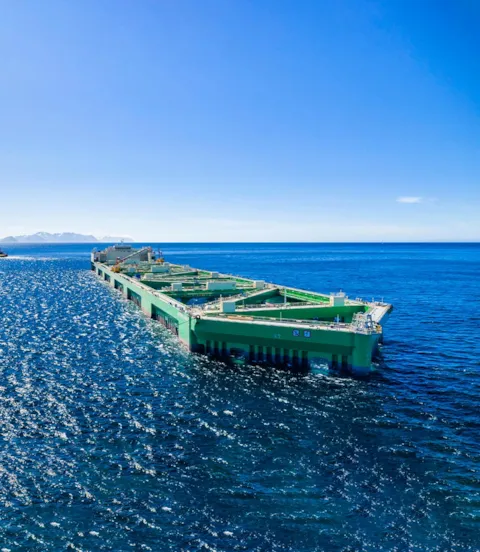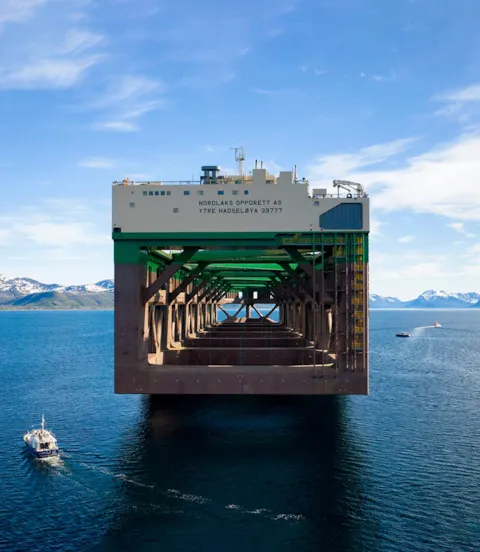Offshore aquaculture: Setting out to feed the world
As the world’s population continues to grow, options for producing enough food are becoming limited. The oceans offer a vast opportunity to meet this demand with sustainable, safe and efficient offshore fish farming.
Expert consensus is that only around two per cent of the world’s food energy for human consumption comes from the sea. While salmon and other farmed fish can be a sustainable source of protein, fish farming at a scale large enough to meet the world’s growing need for protein requires a huge amount of physical space. With areas for traditional aquaculture becoming scarce, offshore fish farming is emerging as an attractive alternative.

Growing markets in offshore aquaculture
In step with the increasing demand for protein, demand for seafood is generally expected to grow significantly in the coming years. “Stakeholders are recognizing that they will need to employ new technologies and solutions in order to meet this demand,” says Frode Kamsvåg, Business Development Leader Marine Structures at DNV GL.
The Norwegian authorities have stated their intention of increasing farmed fish production volumes five- or sixfold by 2050. Norwegian aquaculture giant SalMar intends to double their production by 2030 through the use of their Ocean Farm and Smart Fish Farm concepts. “They see limited growth potential in conventional nearshore aquaculture,” Kamsvåg notes. “In order to meet their production goal, they plan to build offshore units. This is indicative of industry trends. The leading players are looking offshore for new growth.”

Showing the way offshore
He observes that Norwegian owners have been the first to make major investments in offshore fish farming. “Norway is currently serving as a test bed for new concepts and best practices. Stakeholders are working to update and refine parameters for the approval and operation of safe, dependable future solutions.
New nations are emerging as potential growth markets for offshore aquaculture as well, among them China, Kamsvåg reports. “China represents a significant growth market, and stakeholders there see the experience from Norway and the North Sea as very valuable.” DNV GL has a long history of working with various projects in China, he notes, emphasizing that strong, existing partnerships provide a robust platform for building global growth in this burgeoning industry.

Defining a new offshore industry for fish farms
Per Arild Åland, Business Development Manager at DNV GL, explains that the generic definition “offshore fish farm” has come to mean large steel-construction fish pens intended for placement in harsh marine environments. “These units are not necessarily located offshore in the same sense as oil and gas rigs, but they can be placed in exposed waters to take advantage of the effects of currents and improved water quality.” Built in keeping with offshore oil and gas standards, they are larger and more robust than traditional pens. The new units also incorporate new levels of automation and other features designed to improve fish health and streamline operations.
Learn more about our project here >>
DNV GL has classed six such installations operating in Norway. Among them, Midt-Norsk Havbruk has developed Aquatraz, with four units in operation in mid-Norway. Another, Nordlaks’ vessel Jostein Albert, is a true behemoth, measuring 385 metres in length, with room for 10,000 tons of salmon. Ocean Farm 1 from SalMar is equally as impressive, at 68 metres in height and 110 metres in diameter, with a volume of 250,000 cubic metres. In addition to the projects in Norway, Åland cites several under consideration in Singapore and China, with Approval in Concept already provided for some.

An emerging market for offshore aquaculture supply vessels
“New types of structures are needed to make the move offshore, and new vessels will be needed to support these units,” Frode Kamsvåg notes. While numerous smaller vessels supply the near-shore pens today, further out at sea, the need will be for fewer, but more robust craft. “These new workboats will most likely resemble typical offshore supply vessels,” he says.
New fuel and power systems will also be required to meet future emissions requirements, Kamsvåg notes. “Though some units will be fairly far out at sea, the supply boats will be travelling manageable distances to the pens, allowing greater flexibility for power and fuel options.
He believes the offshore aquaculture supply vessel segment has the potential to develop into its own market niche, with various geographic markets requiring specific solutions as well. “The North Sea climate is harsh with frequent storms, while America and Asia experience extreme seasonal weather. All these factors will have to be considered in order to serve a global offshore fish farming industry.

Matching technology to challenges of aquaculture
“Where new technologies are being applied, strict qualifying procedures are needed, but this also applies for known technology that will be used in new ways,” Kamsvåg says.
He confirms the need for learning by doing in the search for new solutions, all the while taking into account new risks. “The application of proven risk management principles will be essential in this learning process,” he emphasizes.

Seeing the bigger picture for offshore aquaculture
Bente Pretlove, Programme Director Ocean Space at DNV GL, cautions against a one-sided focus on technology in the push to move offshore. “It is very important to combine technological expertise with a basic awareness of fish health and welfare,” she maintains. “We need to combine our grasp of technology with an understanding of how fish thrive. For example, in rough conditions, salmon get seasick when being transported by well boats. This can induce an increased stress response, resulting in severe wounds and other injuries. With longer journeys from offshore pens to shore, this problem is exaggerated and must be addressed with new knowledge.”
Acknowledging that offshore fish farming will face competition from other concepts is also important, she adds, citing land-based aquaculture as a key competitor. “Operations on land are very well controlled, and they can also be located closer to markets. Offshore aquaculture is suited for many regions, but land-based farms will provide viable competition in others.”

Ocean industries becoming more complex
Pretlove notes that the ocean industries are evolving from an experience-based past to a knowledge-based future. “Aquaculture has undergone a shift from the work being conducted by personnel on the pens, to more automated and remote operations,” she observes.
“In this setting of increased complexity, barrier management becomes more important, working to reduce the likelihood of negative incidents, or the consequences should they occur.” The new setting requires more professional implementation of risk management in HSE, training of staff, and finding new ways to keep people safe, she maintains, noting that advanced digital technologies must also be applied to provide operators with the necessary safeguards.

Crew needs to handle complex systems
“The new offshore facilities are huge, and crew will need to be able to handle complex systems,” says Pretlove. While the demand for novel solutions presents challenges, she believes this will contribute to the attractiveness of the industry for new talent, and new investment. “We are looking at a new generation of ocean aquaculture. Engineers and investors will need to embrace advanced, hybrid competencies and technologies in order to serve this emerging market.”
- dirk - stock.adobe.com
- Nordlaks
- SalMar
- Nordlaks